|
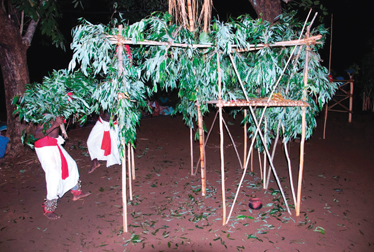 'Nae
Yakkun Nateema' : 'Nae
Yakkun Nateema' :
Magic in the Night
by Husna Inayathullah
You can call is a cultural event, a pooja or a devil dance. But to
the Vedda population in Sri Lanka ‘Nae Yakkun (relative spirit) Nateema
is a deeply poignant ritual invoking the spirit of the dead relatives to
save the life of a loved one suffering from a serious ailment.
At least in this instance it was, when a significant portion of
the Vedda population in Dambana gathered to perform the ancient ritual
to invoke the blessings of the dead relatives to cure the ailing
youngest son of their leader, Vishwakeerthi Wanaspathi Uruwarige Wannila
Aththo.
Though disease and death are no strangers to the indigenous
community, treating the sick often includes worshipping and making
incantations to their Nae Yakkas, followed by other customary rituals,
which have endured despite the many changes the community has undergone.
The rituals are based on the belief that disease and calamity are
brought forth by the unhappy spirit and the only way to avert this is to
invoke their blessings of the Nae Yakka and other spirits.
 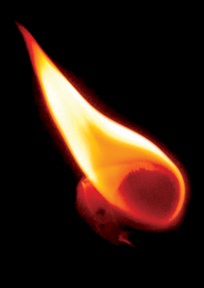 Deeply
arcane, ‘Nae Yakkun Nateema is a midnight ceremony where the rhythm of
the drums, and the smoke and shadows cast by the hand made torches
contribute to the aura of magic and mystery and dark thoughts. The
ritual is conducted mainly to cure illnesses, with the patient propped
on a low seat in a corner. Deeply
arcane, ‘Nae Yakkun Nateema is a midnight ceremony where the rhythm of
the drums, and the smoke and shadows cast by the hand made torches
contribute to the aura of magic and mystery and dark thoughts. The
ritual is conducted mainly to cure illnesses, with the patient propped
on a low seat in a corner.
As with other communities modern and traditional, the Veddas too use
medicinal remedies as a first line of cure. However, they fall back on
the ancient rituals when pills and poultices fail, taking the patient to
the Gurunnanseya, (the healer) who lives in the middle of the forest. He
then gives a ‘nimiththa’ (auspicious time) determining the date and time
to conduct the ritual.
The Veddas then make the ‘yakuma’ for the pooja, bringing in logs and
barks of trees from the forest. They also collect Nathu, Damba and Andu
leaves, and bring them to the destination under a blanket of smoke,
ensuring not a speck of dust mars their purity. The leaves are then
placed on the ‘yakuma’ leading to the ‘yakubandima’ which requires the
blessings of the gods and the leader.
Before they start the ritual, the ‘Gale Nayyaka’ who lives in the
mountains is invited, and his forgiveness sought for previous sins
committed by the community.
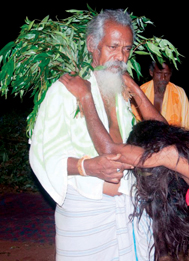 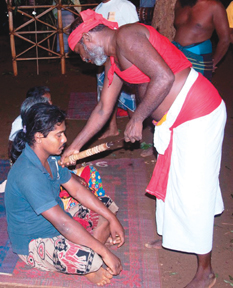 Magical
and mystical the ritual follows a script, which almost seems like a
ghost buster fantasy, for next in the carefully crafted ritual is the
‘adukku mutti’ (set of pots) for the seven devils whose blessing are
invoked. The contents in each of the pot varies according to individual
desires, are prepared separately and include such stuff as kevum,
coconut rings, betel leaves, coins, bead chains and handkerchiefs. Magical
and mystical the ritual follows a script, which almost seems like a
ghost buster fantasy, for next in the carefully crafted ritual is the
‘adukku mutti’ (set of pots) for the seven devils whose blessing are
invoked. The contents in each of the pot varies according to individual
desires, are prepared separately and include such stuff as kevum,
coconut rings, betel leaves, coins, bead chains and handkerchiefs.
The Veddas believe the ritual will not only cure illnesses but also
bless them in their hunting endeavours. The first ‘mutti’ is given to
the biggest devil, who is the ‘Indikoile yakko or Indikoile kiri amma’,
the second to ‘Kanda yakka’. Others in the list include ‘Wanni Bandara
Deviyo’, ‘Sambali amma’, ‘Kukulapola Kiri amma’, ‘Gale hela nae yyakun’
and ‘Malagiya naya’.
The command for the dance is given by the Gurunnanse, which sees the
dancers swirling to the beats until they become unconscious. This is the
omen everyone is waiting for, as it means the spirits making the person
ill have left and now entered the bodies of the dancers. Soon after the
dancers faint they give the pirith to the patient and wish him good
health, bringing an end to the ritual with the blessing of the Vedda
Chief.
This usually happens at midnight when the adukku muttis of the devils
are placed on a pestle.
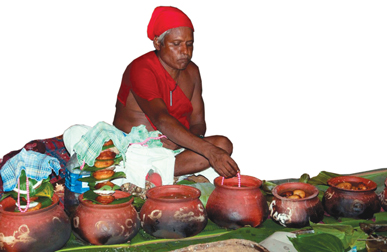 The
Nae Yyakun Nateema is not just a charade or interval designed to
entertain but is a carefully crafted ritual with a history reaching far
back into Sri Lanka's pre-Buddhist past. It combines ancient Ayurvedic
concepts of disease causation with deft psychological manipulation.
Lasting up to twelve hours, it mixes raucous humour with deep-rooted
fears to create a healing catharsis for both patient and community. The
Nae Yakkun Nateema is significant in the world culture because it
depicts how the ancient fables of the devil are still being performed
even today. The
Nae Yyakun Nateema is not just a charade or interval designed to
entertain but is a carefully crafted ritual with a history reaching far
back into Sri Lanka's pre-Buddhist past. It combines ancient Ayurvedic
concepts of disease causation with deft psychological manipulation.
Lasting up to twelve hours, it mixes raucous humour with deep-rooted
fears to create a healing catharsis for both patient and community. The
Nae Yakkun Nateema is significant in the world culture because it
depicts how the ancient fables of the devil are still being performed
even today.
In Sinhalese belief, diseases are either caused by the natural or the
supernatural. In the case of the natural, traditional Ayurvedic or
medical avenues are pursued. In the case of the supernatural or where
the other systems fail, they have traditionally turned to the edura for
aid through such rituals as the Nae Yakkun Nateema.
However, it is the cause rather than the symptom that must be
addressed. In the case of the supernatural it is the ‘ yakku’ demons who
are the cause. These disease-afflicting demons are known as the ‘sanni
yakku’. They are a group of demons who in past battles with the Buddha
were ultimately banished from earth. Living under the loose control of
their King Vesamuni, the yakku are unable to appear physically upon the
earth but retain the power to afflict and through the influence of the
Buddha to heal.
|

